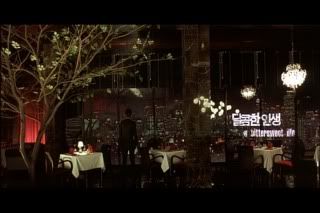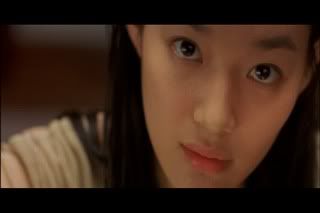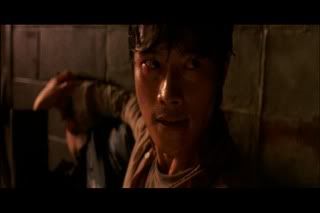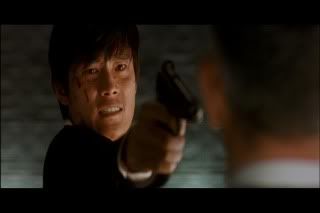
It’s a familiar story: our hero, Sun-woo (Lee Byung-hun), is a serious gangster, an enforcer for Mr. Kang. When Mr. Kang leaves town, he asks Sun-woo to look after his young girlfriend, Heesoo (Shin Min-a). Oh, and Heesoo might have a lover--if she does, kill ’em both.
And so Sun-woo takes on the job, inevitably falling in love with the elegant Heesoo. When he discovers that she does, in fact, have a lover, he is both heartbroken and duty-bound to exterminate them. Except, of course, he shows mercy. Bad form for a gangster.
When Mr. Kang returns, he is less than pleased. Allying himself with Sun-woo’s rival, Baek Jr., Kang sends his son and his men to track down Sun-woo, torture him, and kill him. But Sun-woo won’t go down so easily, and once he decides to go after his old partners in crime, nothing will stop him, not until he kills every last one of those motherfuckers.

So, Kim Ji-woon’s A Bittersweet Life presents nothing new, at least, not insofar as narrative goes. But then again, how many original gangster films are there? It seems like a necessarily limited genre. That’s hardly the point. What A Bittersweet Life does is take a familiar story and tell it with beautiful people wearing beautiful clothing. These beautiful people are filmed with immaculately composed shots--a moving watercolour in Technicolor.
And when violence occurs--and it does, readily--it’s like this veneer of beauty is brutally, horrifically torn open. The violence is at least two-fold--violence to the man, and violence to the image.

What oddly strikes me, on a second viewing of the film, is the focus on clothing. Sun-woo’s suits are sleek, well-tailored, and expensive looking. Hardly what a gangster needs to wear when he’s scheduled for a knife fight. Our (and Sun-woo’s) first glimpse of Heesoo is her feet, as she tries on different shoes. Baek Jr.’s enforcer, when he comes after Sun-woo, is set apart by his eccentric choice of headwear: a shapeless fishing hat. The man’s psychopathology is hinted at, to the audience, not by his actions, but by his hat. A Bittersweet Life is a world of surface. We’re accustomed to looking beneath the surface to find deeper meaning. Here, we just find blood.
In this film, violence hurts. Bullets aren’t just magic dots that render their victims lifeless; instead, they’re little explosions, ripping their victims apart. Bullets don’t just thud into a gangster’s chest, but blow off his fingers, crack open his elbow. Blood smears the aesthetically-designed world around him.
 >
>As I said, the narrative of the film follows a pretty standard trajectory. And that’s part of the fun, I suppose; when you pick up a gangster film, you get some pleasure out of the familiar, out of knowing what you’re in for. The surprise comes from the quality of the acting, and the beauty (there’s that word again) of the film itself.
Kim Ji-woon is a fascinating director. Other than A Bittersweet Life, he’s given us the postmodern “Eastern Western” The Good, The Bad, and The Weird, the psychological horror A Tale of Two Sisters, and the wrestling-centered comedy Foul King, among others. He’s one of Korea’s directors to watch, a group including Park Chan-wook (Oldboy) and Bong Joon-ho (The Host). Korea, to my mind, put out some of the most interesting films of the last decade; here's hoping it only gets better during this one.










1 comment:
nice piece.
Post a Comment